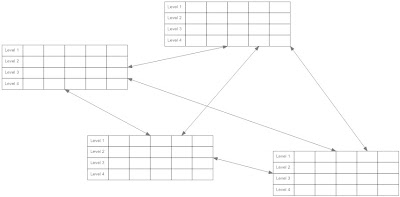Of fMRI and Similar Purported Tools for Observing or Inferring States of the Human Mind and Heart
Suppose that the small italicized letters below (f, g, etc.) represent events at a particular physical level of the brain; e.g., f may represent an electrical signal at a synapse.
Suppose that events of type f are observed at Level 1 and observations done to date shows that the pattern of f events at Level 1 occurs (or: has occurred, has been observed to occur) when deception occurs (or: has occurred, has been observed to occur, has been thought to occur).
What can one infer from those observations?

Does it matter for inferences about deception that events at Level 2 have not been observed in relationship to instances of deception?
Possibly.
It is logically possible that more that one pattern of events at Level 2 can produce the pattern of events at Level 1 but that only one pattern of events at Level 2 is related to observed instances of deception.
But the same relationship may hold between (i) events at any level and events at a lower level and (ii) events at any lower level and instances of deception. Thus, while only some patterns of events at Level 2 are associated with deception, the probative force of those patterns can in their turn fall victim to the (possible) fact that only one pattern of events at Level 3 is associated with instances of deception. These relationships may be repeated down to the "bottom," which in the above table are quantum processes and events. If so, invariant connections between events and instances of deception cannot be established unless and until observations of quantum level events have been observed.
But it is possible that the structure of the workings of the brain is more complicated (and, perhaps, also less bottom-up driven than is the case with Figure 1). It is possible -- is it possible? -- there are interactions between different Levels of the brain, interactions that affect the pattern of events at each Level of the brain. For example:

And then, of course, it is possible (is it possible?) there are interactions among different parts of the brain (which I will assume, for the sake of convenience, have four levels [though it is practically certain that each part of the brain has more than four levels of "existence"]):The interaction hypothesized in Figure 2 assumes that the processes at each level are not "deterministic" within each level. However, the logic of Figure 2 does not preclude the possibility that all the processes in Figure 1, taken together, are "deterministic" (even if only probabilistically so).

Coming soon: the law of evidence on Spindle Law
Browser-based evidence marshaling: MarshalPlan in your browser
